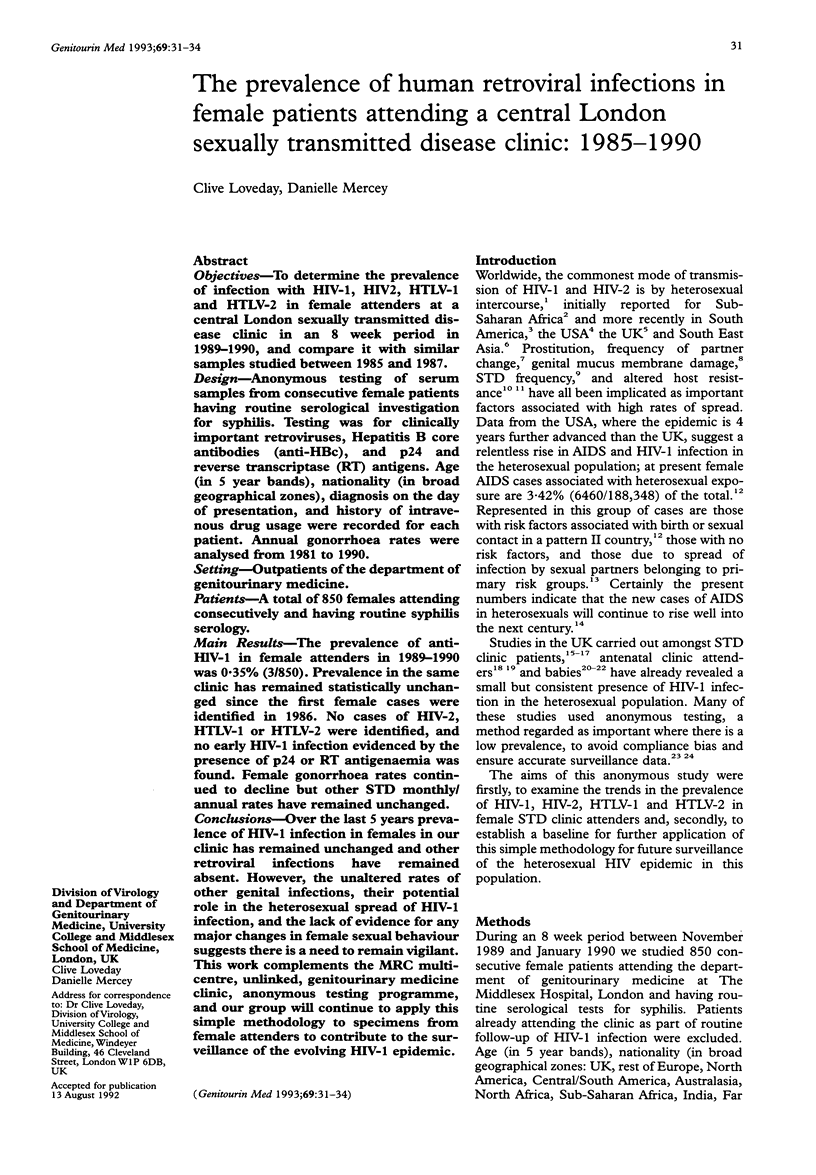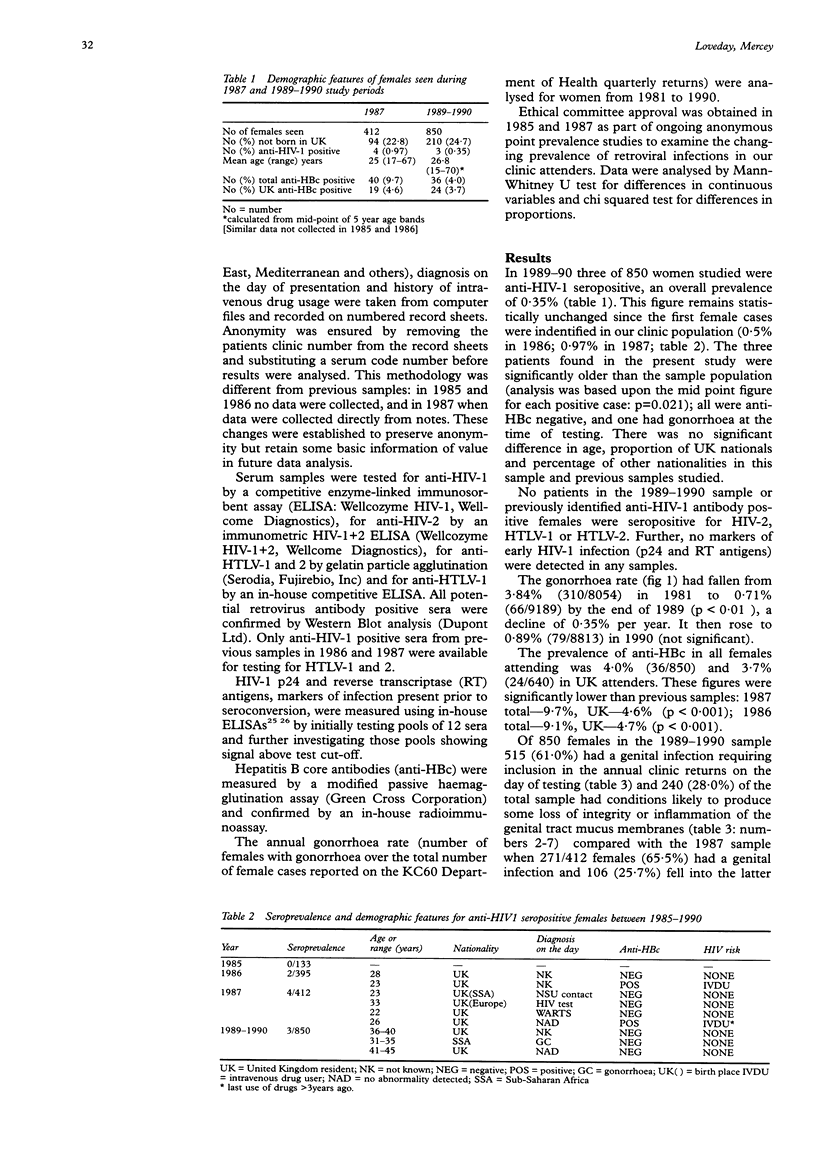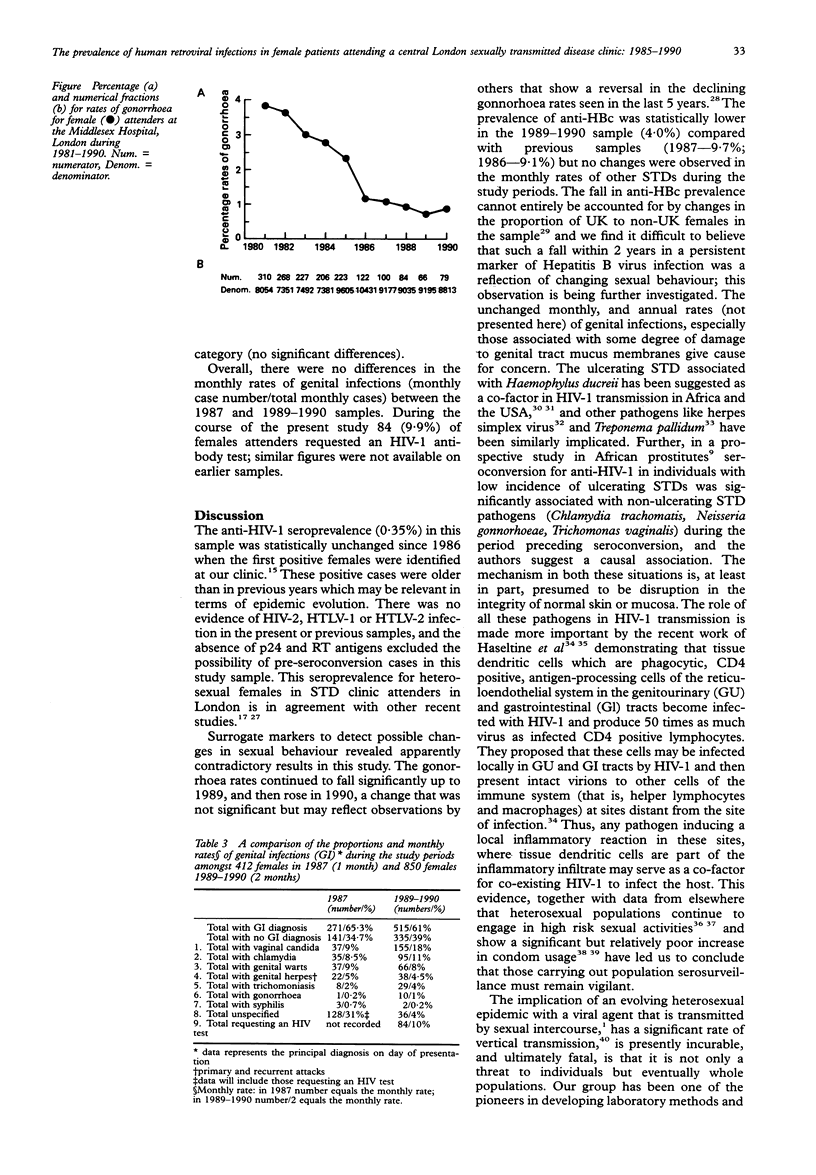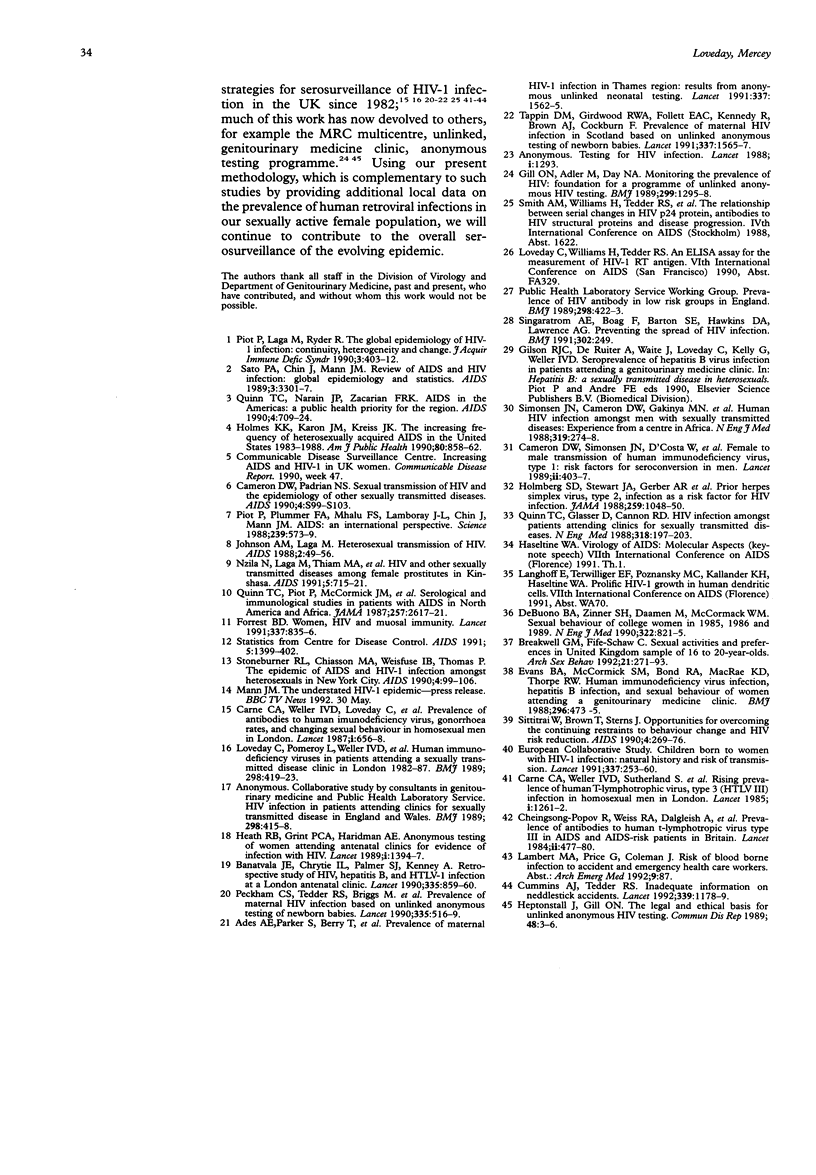Abstract
OBJECTIVES--To determine the prevalence of infection with HIV-1, HIV2, HTLV-1 and HTLV-2 in female attenders at a central London sexually transmitted disease clinic in an 8 week period in 1989-1990, and compare it with similar samples studied between 1985 and 1987. DESIGN--Anonymous testing of serum samples from consecutive female patients having routine serological investigation for syphilis. Testing was for clinically important retroviruses, Hepatitis B core antibodies (anti-HBc), and p24 and reverse transcriptase (RT) antigens. Age (in 5 year bands), nationality (in broad geographical zones), diagnosis on the day of presentation, and history of intravenous drug usage were recorded for each patient. Annual gonorrhoea rates were analysed from 1981 to 1990. SETTING--Outpatients of the department of genitourinary medicine. PATIENTS--A total of 850 females attending consecutively and having routine syphilis serology. MAIN RESULTS--The prevalence of anti-HIV-1 in female attenders in 1989-1990 was 0.35% (3/850). Prevalence in the same clinic has remained statistically unchanged since the first female cases were identified in 1986. No cases of HIV-2, HTLV-1 or HTLV-2 were identified, and no early HIV-1 infection evidenced by the presence of p24 or RT antigenaemia was found. Female gonorrhoea rates continued to decline but other STD monthly/annual rates have remained unchanged. CONCLUSIONS--Over the last 5 years prevalence of HIV-1 infection in females in our clinic has remained unchanged and other retroviral infections have remained absent. However, the unaltered rates of other genital infections, their potential role in the heterosexual spread of HIV-1 infection, and the lack of evidence for any major changes in female sexual behaviour suggests there is a need to remain vigilant. This work complements the MRC multicentre, unlinked, genitourinary medicine clinic, anonymous testing programme, and our group will continue to apply this simple methodology to specimens from female attenders to contribute to the surveillance of the evolving HIV-1 epidemic.
Full text
PDF



Selected References
These references are in PubMed. This may not be the complete list of references from this article.
- Ades A. E., Parker S., Berry T., Holland F. J., Davison C. F., Cubitt D., Hjelm M., Wilcox A. H., Hudson C. N., Briggs M. Prevalence of maternal HIV-1 infection in Thames regions: results from anonymous unlinked neonatal testing. Lancet. 1991 Jun 29;337(8757):1562–1565. doi: 10.1016/0140-6736(91)93260-g. [DOI] [PubMed] [Google Scholar]
- Banatvala J. E., Chrystie I. L., Palmer S. J., Kenney A. Retrospective study of HIV, hepatitis B, and HTLV-I infection at a London antenatal clinic. Lancet. 1990 Apr 7;335(8693):859–860. doi: 10.1016/0140-6736(90)90977-d. [DOI] [PubMed] [Google Scholar]
- Breakwell G. M., Fife-Schaw C. Sexual activities and preferences in a United Kingdom sample of 16 to 20-year-olds. Arch Sex Behav. 1992 Jun;21(3):271–293. doi: 10.1007/BF01542997. [DOI] [PubMed] [Google Scholar]
- Cameron D. W., Padian N. S. Sexual transmission of HIV and the epidemiology of other sexually transmitted diseases. AIDS. 1990;4 (Suppl 1):S99–103. [PubMed] [Google Scholar]
- Cameron D. W., Simonsen J. N., D'Costa L. J., Ronald A. R., Maitha G. M., Gakinya M. N., Cheang M., Ndinya-Achola J. O., Piot P., Brunham R. C. Female to male transmission of human immunodeficiency virus type 1: risk factors for seroconversion in men. Lancet. 1989 Aug 19;2(8660):403–407. doi: 10.1016/s0140-6736(89)90589-8. [DOI] [PubMed] [Google Scholar]
- Carne C. A., Weller I. V., Johnson A. M., Loveday C., Pearce F., Hawkins A., Smith A., Williams P., Tedder R. S., Adler M. W. Prevalence of antibodies to human immunodeficiency virus, gonorrhoea rates, and changed sexual behaviour in homosexual men in London. Lancet. 1987 Mar 21;1(8534):656–658. doi: 10.1016/s0140-6736(87)90415-6. [DOI] [PubMed] [Google Scholar]
- Carne C. A., Weller I. V., Sutherland S., Cheingsong-Popov R., Ferns R. B., Williams P., Mindel A., Tedder R., Adler M. W. Rising prevalence of human T-lymphotropic virus type III (HTLV-III) infection in homosexual men in London. Lancet. 1985 Jun 1;1(8440):1261–1262. doi: 10.1016/s0140-6736(85)92324-4. [DOI] [PubMed] [Google Scholar]
- Cheingsong-Popov R., Weiss R. A., Dalgleish A., Tedder R. S., Shanson D. C., Jeffries D. J., Ferns R. B., Briggs E. M., Weller I. V., Mitton S. Prevalence of antibody to human T-lymphotropic virus type III in AIDS and AIDS-risk patients in Britain. Lancet. 1984 Sep 1;2(8401):477–480. doi: 10.1016/s0140-6736(84)92562-5. [DOI] [PubMed] [Google Scholar]
- Cummins A. J., Tedder R. S. Inadequate information on needlestick accidents. Lancet. 1992 May 9;339(8802):1178–1179. doi: 10.1016/0140-6736(92)90784-z. [DOI] [PubMed] [Google Scholar]
- DeBuono B. A., Zinner S. H., Daamen M., McCormack W. M. Sexual behavior of college women in 1975, 1986, and 1989. N Engl J Med. 1990 Mar 22;322(12):821–825. doi: 10.1056/NEJM199003223221206. [DOI] [PubMed] [Google Scholar]
- Evans B. A., McCormack S. M., Bond R. A., MacRae K. D., Thorp R. W. Human immunodeficiency virus infection, hepatitis B virus infection, and sexual behaviour of women attending a genitourinary medicine clinic. Br Med J (Clin Res Ed) 1988 Feb 13;296(6620):473–475. doi: 10.1136/bmj.296.6620.473. [DOI] [PMC free article] [PubMed] [Google Scholar]
- Forrest B. D. Women, HIV, and mucosal immunity. Lancet. 1991 Apr 6;337(8745):835–836. doi: 10.1016/0140-6736(91)92527-9. [DOI] [PubMed] [Google Scholar]
- Gill O. N., Adler M. W., Day N. E. Monitoring the prevalence of HIV. BMJ. 1989 Nov 25;299(6711):1295–1298. doi: 10.1136/bmj.299.6711.1295. [DOI] [PMC free article] [PubMed] [Google Scholar]
- Holmberg S. D., Stewart J. A., Gerber A. R., Byers R. H., Lee F. K., O'Malley P. M., Nahmias A. J. Prior herpes simplex virus type 2 infection as a risk factor for HIV infection. JAMA. 1988 Feb 19;259(7):1048–1050. [PubMed] [Google Scholar]
- Holmes K. K., Karon J. M., Kreiss J. The increasing frequency of heterosexually acquired AIDS in the United States, 1983-88. Am J Public Health. 1990 Jul;80(7):858–863. doi: 10.2105/ajph.80.7.858. [DOI] [PMC free article] [PubMed] [Google Scholar]
- Hypoglycaemic unawareness and human insulin. Lancet. 1989 Jun 17;1(8651):1394–1395. [PubMed] [Google Scholar]
- Loveday C., Pomeroy L., Weller I. V., Quirk J., Hawkins A., Williams H., Smith A., Williams P., Tedder R. S., Adler M. W. Human immunodeficiency viruses in patients attending a sexually transmitted disease clinic in London, 1982-7. BMJ. 1989 Feb 18;298(6671):419–422. doi: 10.1136/bmj.298.6671.419. [DOI] [PMC free article] [PubMed] [Google Scholar]
- Nzila N., Laga M., Thiam M. A., Mayimona K., Edidi B., Van Dyck E., Behets F., Hassig S., Nelson A., Mokwa K. HIV and other sexually transmitted diseases among female prostitutes in Kinshasa. AIDS. 1991 Jun;5(6):715–721. doi: 10.1097/00002030-199106000-00011. [DOI] [PubMed] [Google Scholar]
- Peckham C. S., Tedder R. S., Briggs M., Ades A. E., Hjelm M., Wilcox A. H., Parra-Mejia N., O'Connor C. Prevalence of maternal HIV infection based on unlinked anonymous testing of newborn babies. Lancet. 1990 Mar 3;335(8688):516–519. doi: 10.1016/0140-6736(90)90746-r. [DOI] [PubMed] [Google Scholar]
- Piot P., Laga M., Ryder R., Perriëns J., Temmerman M., Heyward W., Curran J. W. The global epidemiology of HIV infection: continuity, heterogeneity, and change. J Acquir Immune Defic Syndr. 1990;3(4):403–412. [PubMed] [Google Scholar]
- Piot P., Plummer F. A., Mhalu F. S., Lamboray J. L., Chin J., Mann J. M. AIDS: an international perspective. Science. 1988 Feb 5;239(4840):573–579. doi: 10.1126/science.3277271. [DOI] [PubMed] [Google Scholar]
- Quinn T. C., Glasser D., Cannon R. O., Matuszak D. L., Dunning R. W., Kline R. L., Campbell C. H., Israel E., Fauci A. S., Hook E. W., 3rd Human immunodeficiency virus infection among patients attending clinics for sexually transmitted diseases. N Engl J Med. 1988 Jan 28;318(4):197–203. doi: 10.1056/NEJM198801283180401. [DOI] [PubMed] [Google Scholar]
- Quinn T. C., Narain J. P., Zacarias F. R. AIDS in the Americas: a public health priority for the region. AIDS. 1990 Aug;4(8):709–724. [PubMed] [Google Scholar]
- Quinn T. C., Piot P., McCormick J. B., Feinsod F. M., Taelman H., Kapita B., Stevens W., Fauci A. S. Serologic and immunologic studies in patients with AIDS in North America and Africa. The potential role of infectious agents as cofactors in human immunodeficiency virus infection. JAMA. 1987 May 15;257(19):2617–2621. [PubMed] [Google Scholar]
- Simonsen J. N., Cameron D. W., Gakinya M. N., Ndinya-Achola J. O., D'Costa L. J., Karasira P., Cheang M., Ronald A. R., Piot P., Plummer F. A. Human immunodeficiency virus infection among men with sexually transmitted diseases. Experience from a center in Africa. N Engl J Med. 1988 Aug 4;319(5):274–278. doi: 10.1056/NEJM198808043190504. [DOI] [PubMed] [Google Scholar]
- Stoneburner R. L., Chiasson M. A., Weisfuse I. B., Thomas P. A. The epidemic of AIDS and HIV-1 infection among heterosexuals in New York City. AIDS. 1990 Feb;4(2):99–106. doi: 10.1097/00002030-199002000-00001. [DOI] [PubMed] [Google Scholar]
- Tappin D. M., Girdwood R. W., Follett E. A., Kennedy R., Brown A. J., Cockburn F. Prevalence of maternal HIV infection in Scotland based on unlinked anonymous testing of newborn babies. Lancet. 1991 Jun 29;337(8757):1565–1567. doi: 10.1016/0140-6736(91)93261-7. [DOI] [PubMed] [Google Scholar]
- World Health Organization Global Programme on AIDS Report of a WHO workshop on the measurement and significance of neutralizing antibody to HIV and SIV. London, 3-5 October 1988. AIDS. 1990 Mar;4(3):269–275. [PubMed] [Google Scholar]


